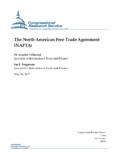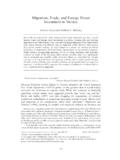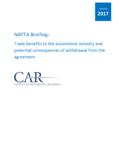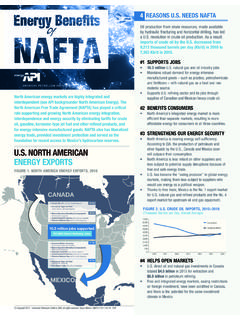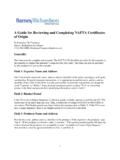Transcription of North American Free Trade Agreement (NAFTA) …
1 North American free Trade Agreement ( nafta ) completion Guidelines Note: These guidelines are to be read in conjunction with the instructions on the reverse side of the certificate of origin. Field 1 (Exporter name and address) List the complete mailing address of the Exporter including the tax identification Field 2 (Blanket Period) The date that the goods are covered by nafta . The nafta can be dated for a specific shipment or over a period not exceeding 365 days. Note: An example of a valid blanket period is January 1, 2005 to December 31, 2005. An example of an invalid blanket period is January 1, 2005 to January 1, 2006. The Blanket certification allows this form to be utilized with multiple importations of the same product over the stated time period.
2 Note: This is only feasible if the products are being repeatedly shipped without significant changes in material costs, sourcing, or production. Field 3 (Producer s Name and Address) Complete this field with one of the following five options: A. The producer's legal name, address and tax identification number; B. If there are multiple producers, a list may be attached identifying additional producers cross referenced to the goods listed in field 5; C. "Available to Canada Customs Upon Request"; D. "Same" if the Exporter (Field 1) and the Producer are the same or; E. "Unknown" (eg: in situations such as Fruit and Vegetable Co ops where the producer(s) cannot be identified).
3 Field 4 (Importer s Name and Address) Complete this field with one of the following three options: A. The importer's complete name, mailing address and tax identification number should be shown. B. Various C. Unknown Note: When indicating Various please include a cover letter indicating the importer of record Field 5 (Description of Goods) List a full and complete description including part numbers of the goods in question. In order to maintain the credibility of the certificate, it is important to use the same information in this field or the certificate as used on the invoice. Note: When completing Field 5, the goods listed on the certificate should also be described in such a way that they can be accurately related to the tariff description of those goods.
4 This applies particularly when words are abbreviated. Example: Part No: 1234 Lmp (lamp) or StCarBlt (Steel Carbon Bolt). Note: A continuation sheet is available for large lists or, as an alternative the list can be on an attachment. Any attached list must include the data required in fields 5, 6, 7, 8, 9, and 10 for each item. If an attachment is used this should be noted in Field 5 of the certificate. Example: As per attached list pages 2 22. Field 6 ( Tariff Classification Number) This field must be complete to at least the subheading level (6 digits). When the specific rule of origin stipulates, this field must be completed to eight digits.
5 Example: or Field 7 (Preference Criteria) Communicates how the goods qualify for the benefits of nafta ) PREFERENCE CRITERION A: The goods are wholly obtained or produced (example: Mined or Grown & Harvested) entirely in Canada, the United States or Mexico. If the product(s) does not meet this definition, then the product(s) cannot be qualified under Criterion A. If it is determined that the product does not qualify under Criterion A, then refer to subsequent Criteria. Note: It is generally assumed that manufactured goods contain at least trace non qualifying content and therefore fail to qualify under Criterion A. A manufactured product(s) rarely qualifies for Criterion A.
6 If this criterion is used, the exporter must supply a nafta for every raw material with Criterion A. PREFERENCE CRITERION B: Under this Criterion the exporter is acknowledging that there is some non originating content incorporated in the product and that this content has been transformed in the manufacturing process. Example: steel bar machined into a finished machine part. It is necessary to review the specific rule (D11 5 2) applying to the tariff classification of each product to determine whether or not the product will qualify under nafta . The rule may include a tariff classification change, regional value content requirement, or both and the good must also satisfy all other applicable requirements of Annex 401 of the nafta Agreement .
7 PREFERENCE CRITERION C: Criterion C indicates that the product(s) being certified was produced from originating materials. Example: Criterion C would apply to copper imported into the United States from Taiwan, fabricated into brass plate which is then further transformed into a brass hinge and exported to Canada. The brass plate would be considered an originating material. PREFERENCE CRITERION D: Two qualifications are specified under Criterion D: i) A product may qualify under Criterion D if it is imported in an unassembled or disassembled form, but is classified as assembled. Example: Bicycles shipped disassembled are classified as assembled).
8 Ii) A product may also qualify under Criterion D if parts from a non originating country are classified in the same subheading of the complete article being imported. In order for a product to qualify under Criterion D, it must meet the requirements of Articles 401(d) and 402, Regional Value Content. Not less than 50% when the NET COST METHOD is used, or not less than 60% when the TRANSACTION VALUE METHOD is used. PREFERENCE CRITERION E: This preference criterion addresses goods listed in Annex , Section "B" concerning Automatic Data Processing Goods and their parts. PREFERENCE CRITERION F: The final criterion pertains to goods listed in Appendix that applies to agricultural goods between Canada and Mexico.
9 It specifically excludes dairy, poultry and eggs. Field 8 (Producer) If both the exporter and signatory on the certificate of origin are the "Producer" of the good(s) at issue, then "YES" should appear in this field 8. Conversely, if the exporter and signatory are not the producer of the goods, then one of the following should be used. A. No (1) knowledge that the product(s) originates B. No (2) written representation other than a nafta that the product(s) originates, or C. No (3) A nafta is supplied from the producer Note: Use of No (1) is not recommended and will frequently trigger a nafta verification audit. Field 9 (Net Cost) A dollar value is not to be indicated in this field.
10 This is a mandatory field that must state NC or NO . NC means goods are subject to Regional Value Content (RVC) and the Net Cost Method was used to calculate the RVC. NO means either: A. the goods are subject to RVC but the Transaction Value Method was used to calculate the RVC, OR B. the goods are not subject to RVC. Regional Value Content must be calculated when the specific rule of Annex 401B stipulates, and when Preference Criterion D applies. Note: When using Preference Criterion A or C , field #9 must be NO Field 10 (Country of Origin) one of these four codes must be entered: CA for Canada US for US origin MX for Mexico origin JNT for joint production Field 11 (Certification Field) All areas of this field must be completed.
